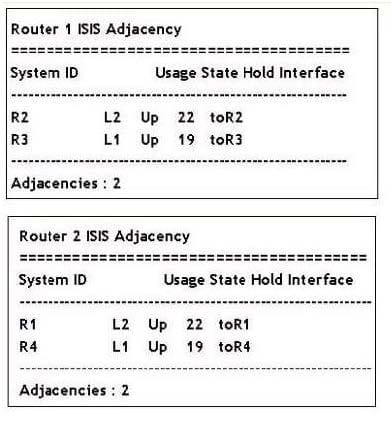Exam Details
Exam Code
:4A0-C01Exam Name
:Nokia NRS II CompositeCertification
:Nokia CertificationsVendor
:NokiaTotal Questions
:922 Q&AsLast Updated
:Apr 01, 2025
Nokia Nokia Certifications 4A0-C01 Questions & Answers
-
Question 851:
What causes an adjacency to change from down to two ways?
A. When a link state update is received in response to a link state request.
B. When a router receives a Hello packet that contains its own router ID in the neighbor list from a neighbor.
C. When a router receives a database description packet from a neighbor.
D. When a link state acknowledgement is received in response to a link state update.
-
Question 852:
What causes an adjacency to change from "Init" to "Two Way"?
A. When a Link State Update is received in response to a Link State Request
B. When a router receives a Hello packet from a neighbor that contains its router id in the neighbor list
C. When OSPF neighbors exchange Database Descriptor packets
D. When a Link State Acknowledgement is received in response to a Link State Update
-
Question 853:
Which of the LSA types stay within an OSPF area and are not exported outside of the area? (Choose all that apply)
A. Router LSA
B. Network LSA
C. Summary Network LSA
D. Summary Router LSA
-
Question 854:
Which of the following statements regarding distance vectors protocols are true? (Choose two answers).
A. RIPv1, RIPv2, and BGP are distance vector protocols.
B. OSPF and IS-IS are distance vector protocols.
C. Routing tables are exchanged between neighbors; however, no routing table is transmitted beyond the immediate neighbor.
D. Distance vector protocols use the Dijkstra SPF algorithm.
E. Routers that participate in distance vector routing protocols maintain full knowledge of distant routers and how they interconnect
-
Question 855:
In which of the following types of areas does an OSPF router not set the E bit in its Type 1 LSA?
A. Not so stubby area
B. Stub area
C. Backbone area
D. Normal area
-
Question 856:
An OSPF ASBR must have at least one interface in the backbone area (area 0)
A. True
B. False
-
Question 857:
Which of the following best describes the type of packets used by OSPF routers to exchange updates on a point-to-point link?
A. IP packets sent to an IP multicast address.
B. TCP packets sent to an IP multicast address.
C. IP packets sent to an IP unicast address.
D. UDP packets sent to an IP multicast address.
-
Question 858:
If two routers running IS-IS protocols are exchanging Hello packets with different authentication types, which of the following statements regarding the adjacency state established between them is true?
A. Different authentication types are not possible because IS-IS only supports password authentication.
B. An adjacency will not be formed
C. The two routers negotiate the authentication type and then reach the up state.
D. Only an L2 adjacency will form, as long as both routers are L2 capable.
-
Question 859:
Click the exhibit button. Assuming point-to-point links, which of the following statements is true?

A. Routers R1 and R2 are L2 routers. Routers R3 and R4 are L1/L2 routers
B. Routers R1, R2, and R4 are L1/L2 routers. Router R3 is an L1 router,
C. Routers R1, R2, and R3 are L2 routers. Router R4 is an L1 router,
D. Routers R1 and R2 are L1/L2 routers. Routers R3 and R4 are L1 routers
-
Question 860:
What is another term to describe the default route for a client?
A. Black hole
B. Default gateway
C. Gateway path
D. Proxy ARP
Related Exams:
4A0-100
Nokia IP Networks and Services Fundamentals4A0-101
Nokia Interior Routing Protocols4A0-102
Nokia Border Gateway Protocol for Internet Routing4A0-103
Nokia Multiprotocol Label Switching4A0-104
Nokia Services Architecture4A0-105
Nokia Virtual Private LAN Services4A0-106
Nokia Virtual Private Routed Networks4A0-107
Nokia Quality of Service4A0-108
Nokia Multicast Protocols4A0-109
Alcatel-Lucent Triple Play Services
Tips on How to Prepare for the Exams
Nowadays, the certification exams become more and more important and required by more and more enterprises when applying for a job. But how to prepare for the exam effectively? How to prepare for the exam in a short time with less efforts? How to get a ideal result and how to find the most reliable resources? Here on Vcedump.com, you will find all the answers. Vcedump.com provide not only Nokia exam questions, answers and explanations but also complete assistance on your exam preparation and certification application. If you are confused on your 4A0-C01 exam preparations and Nokia certification application, do not hesitate to visit our Vcedump.com to find your solutions here.